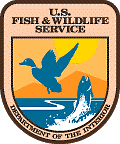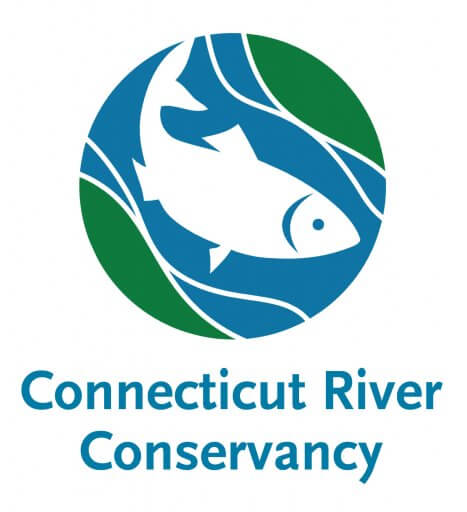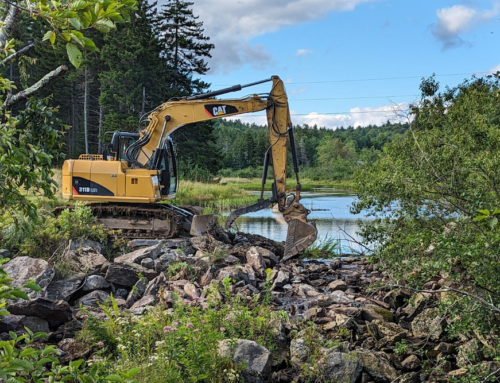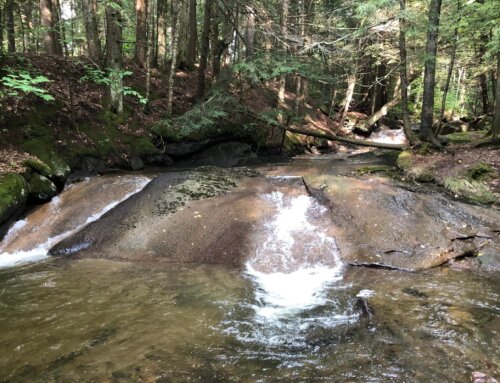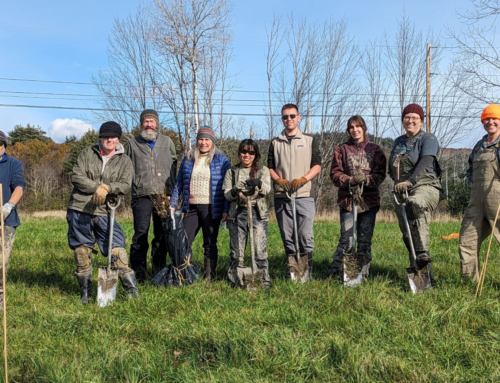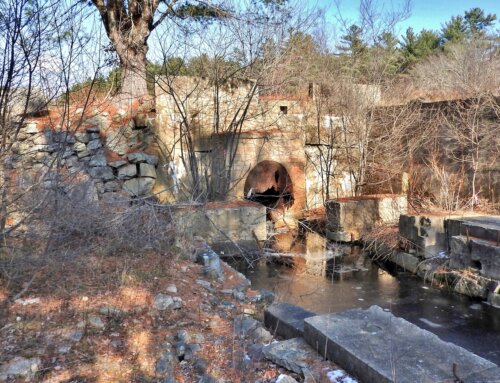Each week, Connecticut River Conservancy volunteers go out to their local tributary rivers in the Connecticut River valley to monitor for river herring as the fish return to freshwater ecosystems to spawn. These dedicated volunteers provide CRC, the CT Department of Energy & Environmental Protection (CT DEEP), US Fish and Wildlife Service (USFWS), and other partners with valuable data to track where river herring are present and absent. CT DEEP and USFWS monitor at several locations and this joint program helps to provide a more comprehensive understanding of the health of our river herring populations. Many thanks to our partners and volunteers who give this program life!
Fish Update from the Waters
Written by Steve Gephard, former fisheries biologist with the CT Department of Energy and Environmental Protection – 06/02/2021
In last week’s update, I mentioned the rainy forecast for the holiday weekend and it came to pass! Some parts of Connecticut got three inches of rain. Streams were roaring with the highest flows we’ve seen all spring. However, the rain seems to have been a coastal event because the Connecticut River only came up modestly, so I assume the upper watershed did not get much rain. Water temperatures dropped back down, too. These conditions are good for prolonging fish migrations and bringing in more fish, particularly fish already in the river but not moving up into spawning areas. However, the question is always whether there are more fish out there. In the case of the Holyoke Fishlift, staff there are suggesting that the runs of lamprey and blueback herring may be over. They did not get a bump from the rain and Ken Sprankle with the USFWS stated that his weekly sampling revealed much fewer bluebacks in the river. The CRC volunteers did not report much action over the last few days but in all fairness, observation conditions were not good. The streams were high and muddy, making it hard to see any fish at all. In fact, now three days after the end of the rain, the Salmon River is still too high to make good observations.
It is difficult to predict the coming week. On one hand, lots of people are suggesting that the river herring runs in Connecticut are about over. On the other hand, this is still pretty early for them to end, judging from past years. We normally see them into the first week or two of June, as the mountain laurels bloom. It has been cool and it has been dry. It is possible that as this high water subsides over the next couple of days, we might see one last gasp. Of course, we have more rain forecasted for Thursday and Friday. If it is a lot, then the streams may go right back up again. If not, they still may drop and offer a chance to see fish.
As the DEEP gets around to viewing fishway video, we will see more numbers. But we have seen a record number of alewives passing through the Moulson Pond (Eightmile River, Lyme) and StanChem (Mattabesset River, Berlin) fishways and there is more video to watch. The DEEP has initiated trucking into Kensington Pond upstream in Berlin and these strong numbers could reflect early sea returns from such trucking.
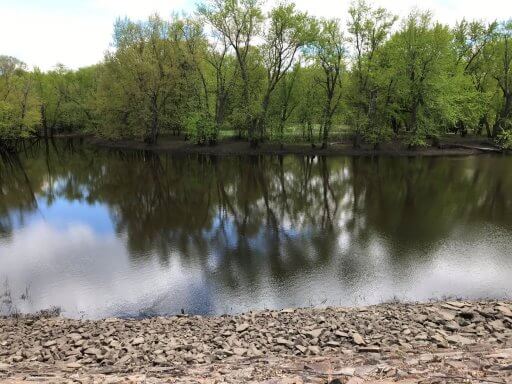
Chicopee River in Chicopee, MA. Photo credit: Joan Plummer.
The shad run is over in the lower river and the netters have pulled their nets. I may have bought some of the last boned filets in Old Saybrook for last night’s dinner. However, the shad are still moving up river and I hope we’ll see the numbers at Holyoke (209,000), Turners Falls (2,800) and Vernon (TBA) continue to rise. The current number at Holyoke is not particularly high.
I was working with Dr. Steve McCormick to collect sea lamprey for a study and we installed a special trap at Leesville (Salmon River) to capture incoming fresh lamprey. We based the timing on the long-term database for the Rainbow Fishway (Farmington River). We captured 1 fish. Now, the lampreys are spawning below the dam, which is generally as sign that they are done migrating. It appears that the species arrives much earlier in the Salmon River than the Farmington and we probably installed our trap too late. We could not accurately project the timing of the Salmon River run because the Leesville fishway has no means to count lamprey so we have no stream-specific data, whereas the Rainbow fishway has a window and video camera which has provided nearly 40 years of data. This shows that we still lack good data on the timing and distribution of some runs and that is why citizen science like what the CRC volunteers are doing can be helpful.
A repeat from last week: The 63rd annual Essex Shad Bake has been cancelled due to COVID but a “virtual shad bake” has been scheduled for June 6. I’ll be giving a short PowerPoint presentation about shad around 4:00 pm. Details will be posted on https://essex.rotary7980gives.org/virtualshadbake2021/
Volunteer River Herring Data from May 26- June 3, 2021
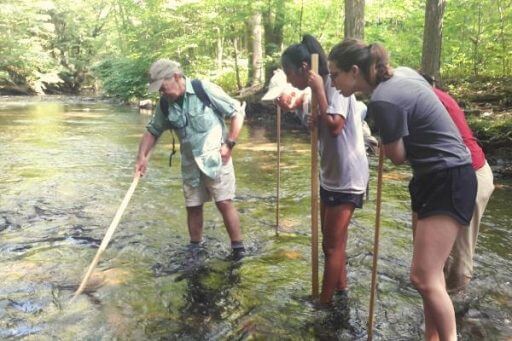
Volunteers looking for sea lamprey nests on the Sawmill River in Montague, MA.
This was the last week of monitoring for our dedicated volunteers: THANK YOU to all participants for the success and continuation of this program. Ken Sprankle and Steve Gephard will confirm, the herring runs are now over and we will hopefully see them again next spring! You may now notice more Shad showing up dead on our river banks, do not be alarmed, that is a natural phenomenon we witness every year after shad spawning season. We are also seeing sea lamprey making their final journey to their spawning habitat, and later this month we will be looking for volunteers to help us count the nests they leave behind.
The map below displays data report from the season through June 1st, but the color of the pin on the map may only reflects the most recent report. To see a more complete dataset, click on the dot, select “latest Measurements” at the top and click anywhere on the graph. This will pull up all of the reports represented so far.
Fishway Count Update
This report is compiled by the U.S. Fish and Wildlife Service, CT River Fish and Wildlife Conservation Office using fishway count data provided by several agencies as well as power companies and is dependent in most cases on the review of video counts, that have an associated time lag for updates. Please click here for more information.
Notable items:
- the holiday weekend’s cold/rain had substantial effects on conditions and also fish passage,
- daily shad counts have “rebounded” somewhat with the milder weather in past 2 days,
- we have seen a rapid decline in blueback herring abundances in lower basin surveys,
- some large juvenile eel passage dates observed (3200 on 5/24), and 5) Sea Lamprey run has come and is largely over in the last 2 weeks in May (17,700 – very low level).
Conte Lab has been having good success running shad from HFL trap and haul facility for passage experiments in the Flume Building over the past weeks.
Written by Ken Sprankle, Project Leader CT River Fish and Wildlife Conservation Office U. S. Fish and Wildlife Service – 06/03/2021
Featured Site: Pine Brook, CT
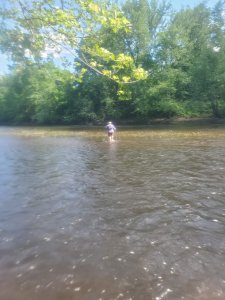
Volunteer looking for migratory fish. Photo credit: Melissa Vanek.
The Pine Brook is a roughly 7 mile long brook nested right in between East Hampton and East Haddam, CT. This brook flows into the Salmon River, just a couples miles upstream of its dam. Dennis, a longterm volunteer of CRC will tell you all about his experience and hopefully will make you want to visit the site too!
Dennis: “When the CRC offered the opportunity to partake in their River Herring observation program I wasn’t sure I was up to the 45 minute drive each way. But I took a ride to Pine Brook a place I wasn’t aware of. As soon as I started walking over the footbridge it became clear this park is something special. I took a walk upstream and found beautiful stone structures, amazing sluiceways and a couple of massive dams that are still mostly there. It is truly staggering thinking of the labor it must’ve taken to build these structures. This small piece along the brook is bordered by the Silvio O. Conte wildlife refuge offering many trails to explore along with two amazing waterfalls! One afternoon the fish were there thrashing and crashing through a riffle making quite the ruckus. I stayed for a couple of hours watching this amazing event and feel privileged having been able to witness it. Every time I visited Pine Brook I gained more knowledge of the area and a better appreciation of all things natural. I thank the CRC people and volunteers for all the hard work they do!“

